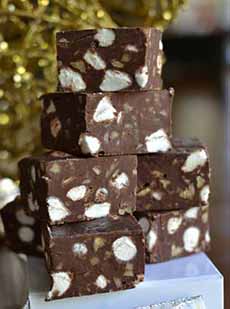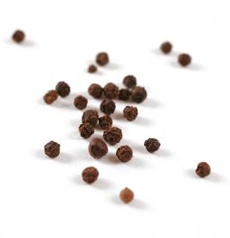|

[1] The fruit salad version of Heavenly Hash, wrapped in sour cream (photo © When The Dinner Bell Rings | Blogspot [now closed].

[2] Heavenly Hash fudge, with chocolate chips, mini marshmallows and pecans. Here’s the recipe from Small Town Woman (photo © Small Town Woman).

[3] Heavenly Hash ice cream, with chocolate chips, marshmallow swirl and sliced almonds (photo © Stewarts Shop).
|
|
February 2nd is National Heavenly Hash Day. But which heavenly hash?
If someone offers you Heavenly Hash, you may want to clarify:
Is it a fruit salad bound with sour cream or whipped cream, or a chocolate confection or baked good filled with marshmallows and nuts?
HEAVENLY HASH: THE FRUIT SALAD
The fruit salad version of Heavenly Hash is a traditional Southern dish. It began as a Christmas recipe with red maraschino cherries, green grapes, pecans and other ingredients folded into whipped cream.
Over generations the recipe evolved, with everyone inventing his or her own hash (the term, after all, indicates a jumble or muddle of ingredients).
So today the recipe for heavenly hash essentially requires some kind of fruit—fresh, canned and/or candied—in some kind of creamy white binder.
We prefer sour cream, but have also found, mayonnaise, pudding, whipped cream, even yogurt or cottage cheese and (gasp!) Cool Whip.
Here are just a few of the combinations we perused:
Fruit cocktail and maraschino cherries
Cherry pie filling and crushed pineapple
Shredded coconut and/or bananas
Grapes and mandarin orange segments
Enhanced with marshmallows and nuts
Flavored with lime Jell-O or vanilla pudding
All folded into the binder
We make Heavenly Hash with fresh fruits (strawberries, bananas, pineapple, peaches) and nuts (a mix of pecans, pistachios and walnuts), folded into crème fraîche or slightly sweetened sour cream.
If the whole concept sounds odd to you, know that Heavenly Hash is very much a comfort food to its fans.
VARIATION: AMBROSIA
Ambrosia is a similar American fruit salad from the South.
While some people use the terms interchangeably, most ambrosia recipes contain coconut and pineapple, mandarin or orange sections, and miniature marshmallows.
As with Heavenly Hash, Ambrosia can also include nuts and maraschino cherries.
We dug up an old Ambrosia recipe from Emeril Lagasse that uses fresh fruits (bananas, berries [3 types], oranges, pineapple), whipped cream and toasted coconut.
And because it’s from a noted chef, there’s a chiffonade fresh mint leaves.
|
HEAVENLY HASH: THE CANDY, CAKE, COOKIE OR ICE CREAM
Folks liked the concept of heavenly hash so much—different ingredients in a creamy base—they ported it into other sweets called Heavenly Hash:
A type of chocolate fudge, with added marshmallows and nuts (photo #2)
A cookie version, folding miniature marshmallows, chopped nuts and coconut in a chocolate cookie dough
A chocolate cake version, chocolate layer cake with marshmallow cream filling and chocolate icing garnished with nuts
An ice cream version: chocolate ice cream with a marshmallow swirl, chopped nuts and chocolate chunks (photo #3—or, use the ingredients with chocolate ice cream, parfait-style)
So enjoy Heavenly Hash Day your style, with one of the ideas above; or freestyle it to create something new.
|





